Last Updated on August 21, 2025 by Packoi Team
Butcher paper and parchment paper are handy tools. Whether you’re cooking in the kitchen, baking, grocery shopping, or simply putting away leftovers, you’ll undoubtedly come across these two materials.
Despite their many similarities, they have key differences because they’re made for different purposes. So, when do you use butcher paper for wrapping sandwiches, and when is it more appropriate to use parchment paper?
Join us as we review what they are, their types, differences, and uses. By the end of this article, you’ll be able to use them according to the benefits they offer!
What Is Butcher Paper?

Butcher paper is made of FDA-approved food-grade wood pulp. Its name was coined by creative salesmen trying to market their products to butchers so that they would utilize their paper in their butchering business, specifically to wrap raw meat and use it as storage for their cut products. This special and thick paper can also be a protective barrier to reduce flavor contamination.
This type of Kraft paper undergoes a specific kind of treatment to strengthen it since it is used for food. It is designed to withstand moisture, blood, oil, and other meat-related moisture without tearing.
Nowadays, butcher paper has become a staple in butcher shops, packaging, and food service. It can also be used in DIY craft projects, gift wrapping, and school projects. Plus, this paper can be an alternative to bird cage liners and bins for bird worms.
6 Common Types of Butcher Paper
There are six kinds of butcher paper available on the market. Though there are notable differences, all are primarily used for cooking and offer food-grade quality.
1. White Butcher Paper
This white paper is similar to craft paper. The main difference between them is that butcher paper goes through a bleaching process to turn the brown pulp into a shade of white. Though white butcher paper is used in several cooking processes, it isn’t the best choice because it is uncoated. Its recommended use is for sandwiches and subs.
Some meat smokers use butcher paper to wrap meat products that undergo smoking because it lets the smoke in and absorbs it without trapping moisture. Besides its use in food products and smoking meats, white butcher paper is also used as a protective barrier or covering on tables during arts and crafts projects.
2. Brown Butcher Paper
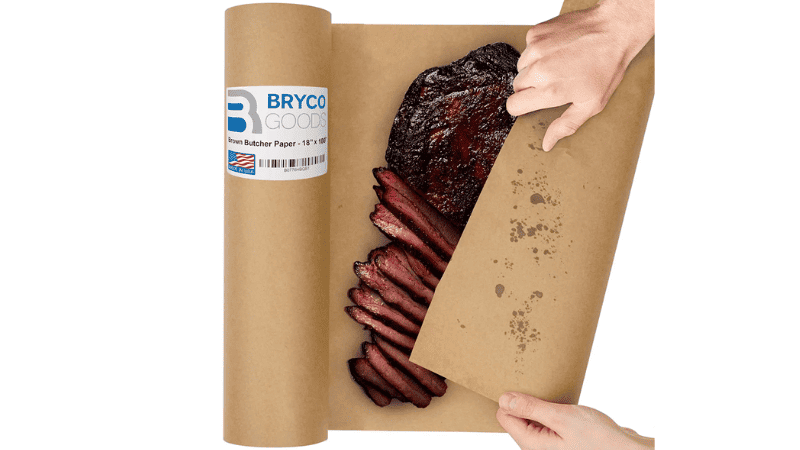
Primarily used as craft paper, this type of butcher paper can also be used to wrap meat, especially smoked meat, for aesthetic packaging. Brown butcher paper uses the same wood pulp designed for cooking without undergoing additional processing. There are also no additives incorporated in brown butcher paper.
3. Pink Butcher Paper
This type of butcher paper is also called peach paper. It’s a staple if you are a smoker or are in the meat-smoking business because it lets the meat absorb the maximum amount of smoke without contaminants. As the name suggests, this paper has a feminine and sweet shade of pink or peach, which is perfect for raw meats. Thanks to its color, it can seamlessly mask the juice or blood coming from it.
Despite the color, it is one of the strongest butcher papers on the market, as it effectively reduces the risk of leaks without the raw meat ever becoming soggy.
4. Pink-Treated Butcher Paper
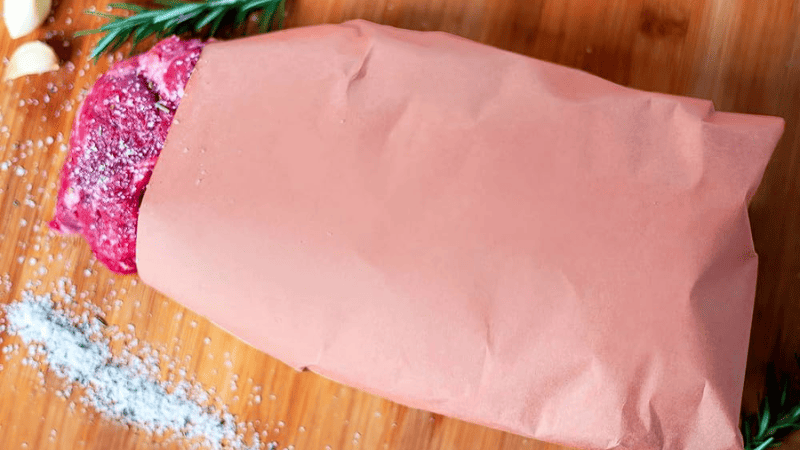
The pink-treated butcher paper shares almost the same characteristics as the regular pink paper or peach butcher paper. The only difference is that the wax coating on this premium paper is subjected to a sizing agent, so it can help preserve fresh-cut meat for storage.
Meat wrapped and stored using pink-treated butcher paper retains its bright red coloring. This allows meat to retain its healthy-looking hue while preserving its freshness.
5. Gardenia Butcher Paper
Gardenia butcher paper is a premium kind of butcher paper. It can provide greater protection against moisture. This is a more eco-friendly option than plastic packaging and can contain juices and oils while still allowing the meat to breathe, thus reducing sogginess.

6. Steak Butcher Paper
As the name suggests, this type of butcher paper is mainly used for pork and beef displays in butcher cases. Wrapping the meat in steak butcher paper will seal in the juices and keep that delicious and healthy red color. This peach-treated butcher paper comes in colors like white, black, peach, and green.
What Is Parchment Paper?
Parchment paper is a baker’s and cook’s best friend. It is a moisture-resistant and extremely thin paper made from cellulose, a vegetable fiber that boasts a non-stick surface with a slippery and smooth coating. Due to its primary purpose, it has earned the name greaseproof paper.
This non-toxic and non-greasy paper is intended for the oven, as it can withstand high temperatures and retain its shape even if it’s exposed to temperatures as high as 450°F.
When you bake, roast, or cook your dish, line your casserole with parchment so you won’t have any problems lifting it out. Using the paper in this way also ensures that there’s little to no mess and that no sticky bits are left behind. So, if you want an effortless and hassle-free clean-up after cooking, make sure you have parchment paper.
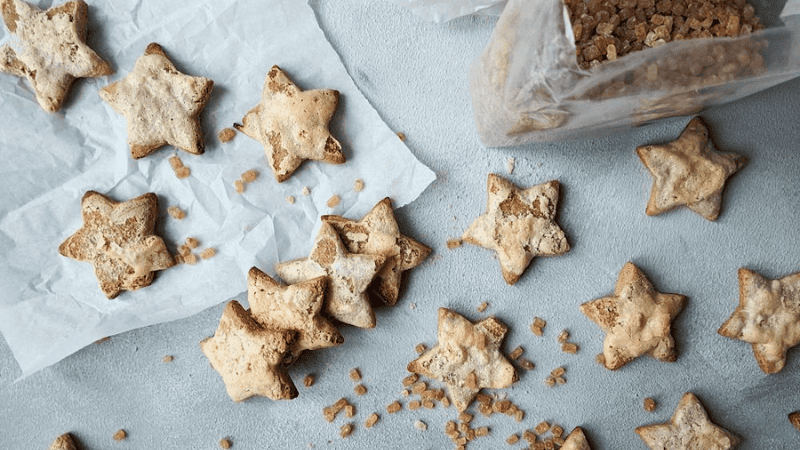
The chaos and clean-up after baking can be tedious and frustrating, so save yourself the trouble by using the right resources.
Parchment paper is readily available in most, if not all, grocery stores, and it usually sits next to aluminum foil and other wax paper and paper.
Types of Parchment Paper
When you’re purchasing parchment paper, you have two choices: bleached parchment paper, which you can easily recognize by its translucent white color, or unbleached parchment paper, which boasts a translucent tan coloring. What’s the difference between these two types of parchment paper?
Bleached Parchment Paper
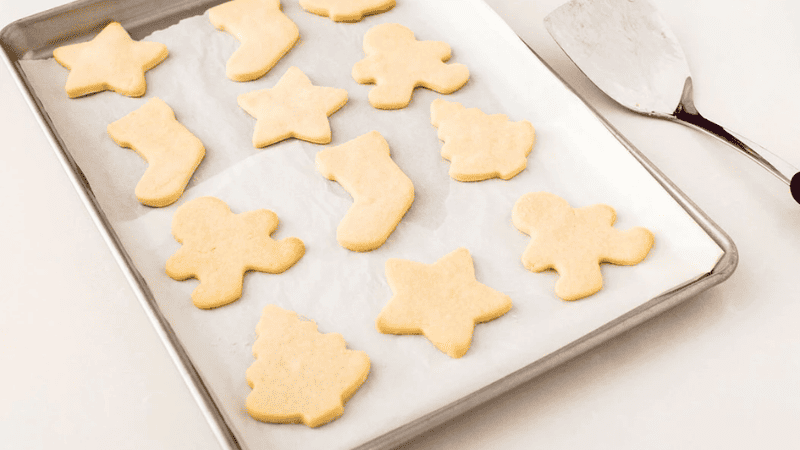
Bleached parchment paper goes through a bleaching process. The chlorine used during manufacturing is responsible for its white color, so in a way, it is considered treated paper.
Unbleached Parchment Paper
In contrast, unbleached parchment doesn’t go through additional processes and treatments. It is 100% chlorine-free. Many opt for this kind of parchment paper for safety reasons. When parchment paper is bleached with chlorine, there is a concern that the process could create a chemical called dioxin.
In high doses, this chemical has been associated with health issues like damage to the immune system, cancer, hormonal changes, reproductive problems, and developmental issues.
Hence, unbleached parchment paper is your best option if you want to use paper that doesn’t give off any odors and leach chemicals into your food while ensuring that the oil is absorbed.

Difference Between Butcher Paper and Parchment Paper
| Feature | Butcher Paper | Parchment Paper | Conclusion |
|---|---|---|---|
| Heat Resistance | Butcher paper can withstand high temperatures up to 300°F (and even higher), making it practical for ovens, BBQ grills, and smokers. | Thanks to its silicone coating, parchment paper can tolerate temperatures of up to 450°F. It is commonly used in cooking and baking, specifically for lining baking sheets, cookie sheets, and pans. | Butcher and parchment paper have impressive heat resistance capabilities . |
| Permeability | Butcher paper is extremely absorbent. You can rely on it to help you produce crispy and non-soggy food because of its ability to release moisture. It can also be used to make smoked food items. | This paper holds in all the moisture from start to finisih so you're more likely to have mushy food. | Between the two, butcher paper is more permeable. It retains enough moisture to keep the meat tender, more flavorful, and juicier without the risk of drying it out. |
| Moisture Resistance | When used for wrapping meats, butcher paper allows just the right amount of moisture to evaporate. However, this also means that it's less resistant to moisture. | Instead of allowing your food to breathe, parchment paper keeps all the moisture in. | If you want to keep your food moist, use parchment paper. If you prefer a drier, more crispy texture, opt for butcher paper. |
Butcher paper and parchment paper are both commonly used in cooking and food preparation, but they have distinct differences in their composition, uses, and properties. Here’s a comparison:
Butcher Paper vs. Parchment Paper: How to Choose the Right Type of Paper
Identifying the correct type of paper to use is critical. Although butcher block paper and parchment paper have similarities, they have distinct differences and benefits.
Don’t let food go to waste or settle for substandard results. Use the right tool for the job. Here are some factors to consider when deciding between butcher paper and parchment paper:

1. Intended Use
Since both papers are primarily used for cooking, you have to make your choice based on what you’re cooking, your cooking methodology, and the results you want.
For example, if you’re baking a cake, a batch of cookies, muffins, and other baked goods, the simple and practical choice is parchment paper. This is a basic tool for any baker. Thanks to the paper’s non-stick surface, you can quickly get your pastries out of your pans and molds while reducing the risk of burning. It also makes clean-up easier.
On the other hand, if you want smoked meats, ribs, bacon, pulled pork, or patties on the grill, the better choice is butcher paper. This type of paper will allow the meat to absorb as much smoke as possible while retaining the right amount of moisture, so your beef, pork, chicken, or fish can absorb the juices and flavors well.
2. Durability and Heat Resistance
Both papers boast heat-resistant properties, so you need to be conscious of how you’re going to use them and what you want to achieve. They can endure high temperatures and will only turn brown if they’ve reached their maximum temperature.
However, know that parchment paper doesn’t manage direct contact with fire well. So, when grilling, it’s best to use butcher paper.
An added note with regards to durability: Butcher paper is thicker and sturdier, so it can support more weight than parchment paper. This makes it the ideal choice when dealing with large cuts of meat.
3. Cost and Availability
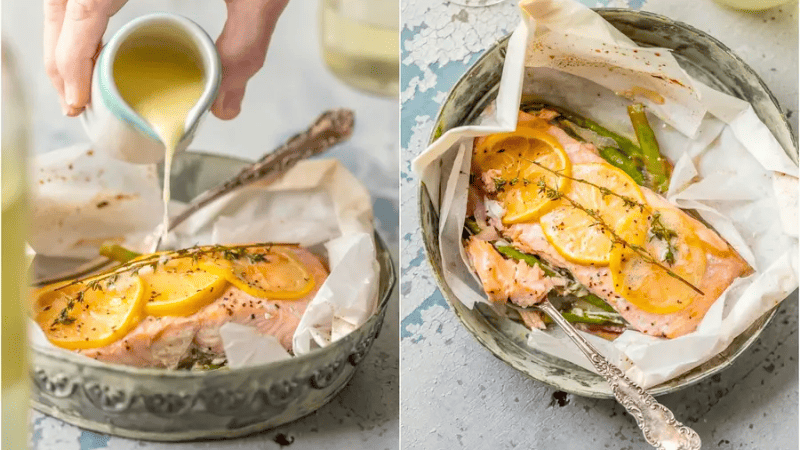
Both parchment papers are affordable. Between the two of them, however, parchment paper is cheaper. Both are conveniently available in most grocery stores and online marketplaces. They’re economical to purchase in bulk if you have a business.
When you walk through the aisles of your stores, it’s easier to locate parchment paper because people are more familiar with it compared to butcher paper. This also means that parchment paper is more readily available.
4. Environmental Considerations
Butcher paper’s primary material is wood pulp, while parchment paper is made of cellulose fiber, making both environmentally safe products. That is, as long as you don’t coat it with non-environment-friendly material like wax paper.

Parchment paper is more economical and practical than the other, as you can use it several times before disposing of it. You can wipe it off with a damp paper towel after removing all the leftover pieces to get rid of residue. Then, let it dry, and it’s ready to be used again. Butcher paper can also be used up to six times, but only if it’s untreated. Otherwise, its recyclability is limited.
5. Health and Safety
To keep food safe, get:
- Butcher paper without any dyes or wax
- Parchment paper that hasn’t been bleached
These options have the FDA’s seal of approval, so they can be used for cooking and other food-related handling, preparation, and storage activities. Note that they must be kept away from external elements to reduce contamination. They should also be sealed and appropriately wrapped upon purchase.
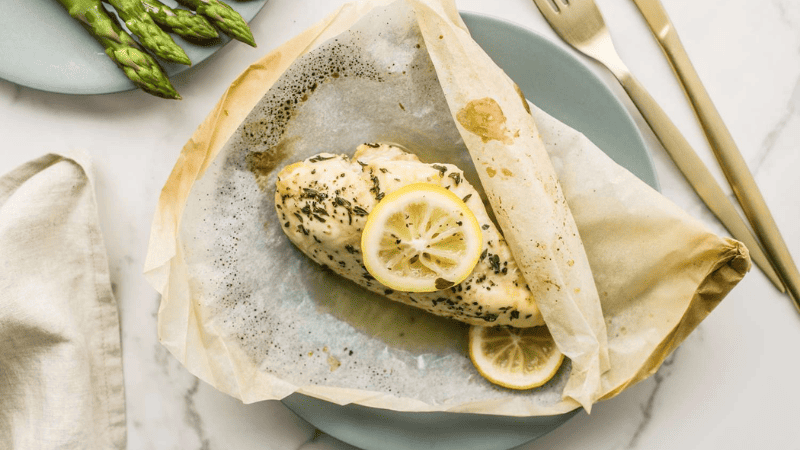
6. Customization and Branding
You can fully customize and incorporate your brand logo and design if you intend to use any of these papers for your business. It’s a matter of finding the right team that can handle the personalization and is professional in handling these materials.
It’s a bonus if you can collaborate with an organization that is into packaging and printing to provide you with an all-in-one solution like Packoi.
7. Packaging
Butcher paper is the right choice if you’re after packaging that can handle weight and larger items, including meat and fish. Since it is thicker and more fibrous, you don’t have to worry about it tearing easily or collapsing. For pastries and smaller food items, you can use parchment paper as your packaging material.
FAQs
Can butcher paper be used in the oven?
Yes, butcher paper can be used in the oven, but only at low to moderate temperatures, unlike parchment paper, which withstands higher heat.
Which is better for smoking meat: butcher paper or parchment paper?
Butcher paper is better for smoking meat because it allows smoke to penetrate while retaining moisture.
Which is more eco-friendly: parchment paper or butcher paper?
Both are eco-friendly if untreated, but parchment paper can often be reused more times before disposal.
Can parchment paper be reused?
Yes, parchment paper can often be reused several times if it’s not overly soiled or burned.
Is parchment paper the same as wax paper?
No, parchment paper is heat-resistant and non-stick, while wax paper is not safe for oven use.
Conclusion
And just like that, you’ve become a kitchen paper pro! Next time, you’ll be a whiz in the kitchen whether you’re cooking, baking, wrapping up food, or preparing meat for the smoker. Sure, parchment paper and butcher paper can be made to serve the same purposes, but there are noticeable and important differences once you’ve used them.
Why settle for subpar results when you don’t have to? All you need to remember is a few key principles:
- Both tolerate heat well, but parchment paper can withstand higher temperatures.
- If you want to release moisture from the meat, use parchment paper. Butcher paper is better for retaining moisture. Butcher paper is also more resistant to moisture.
Packoi: For Perfectly Packaged Kitchen Paper
If you’re a business owner who’s looking to sell these two paper types, Packoi’s packaging solutions can help you ensure that your product looks good no matter where you choose to sell or who you choose to sell to.
Whether you prefer bags or boxes, we have a variety of packaging and printing options to choose from. Visit our website and get a quote quickly!




